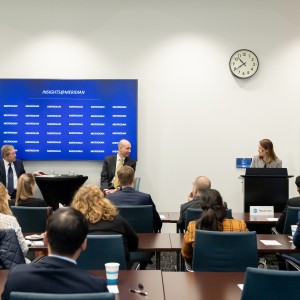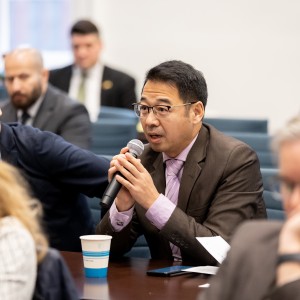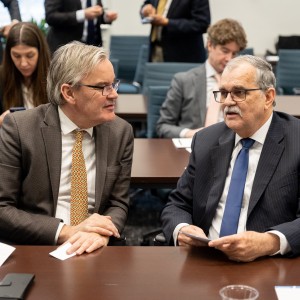Deputy Secretary of Energy David Turk Discusses Climate Crisis and the Path to Clean Energy with Meridian

Over the course of the past decade, climate change has taken center stage in domestic and global affairs. Countries around the world have committed their time and resources to addressing the climate crisis we face today. In the case of the U.S., recent legislation and national and international push have placed the country on a promising path towards climate action.
Deputy Secretary of Energy David M. Turk spoke to an audience of senior diplomatic leadership about the U.S. Department of Energy’s role in the U.S.’s transition to a clean energy infrastructure and discussed the challenges, as well as the opportunities, that countries face as they tackle climate change globally. Moderated by The Honorable James Blanchard, 45th Governor of Michigan and U.S. Ambassador to Canada (1993-1996), the program featured an insightful discussion on the U.S.’s clean energy investments and prospects for multilateral cooperation.
Here are some top takeaways from the program:
1. Counting Down to 2050
Just two months ago, the United States joined a long list of countries pledging to achieve net-zero emissions by 2050 after launching its Net-Zero Government Initiative at COP27. The pledge of the U.S., along with those of other countries, represents an important step in the global fight against climate change. However, pledges can only go so far in achieving net-zero targets. Countries must now confront this daunting challenge head on. In the case of the U.S., a substantial climate bill and an ambitious administration might help make this a reality.
2. The Challenge of Growing Without Polluting
While global CO2 emissions fell by 7% in 2020 due to COVID-19 pandemic lockdowns, emissions quickly returned to pre-pandemic levels once countries began lifting restrictions and revitalizing their economies. This negative correlation between economic productivity and emissions demonstrates that decreasing activity in certain economic sectors is not sustainable for countries in the long-term. Instead, countries should be able to foster economic growth while reducing greenhouse gas emissions. One possible solution to this issue is transitioning economies to low-carbon-emitting technologies.
3. Attacking Climate Change on All Fronts
The Department of Energy is looking to reduce the country's carbon footprint by investing in clean energy technologies that, used together, will help reduce carbon emissions on all fronts. Whether that is doubling down on wind, solar, or hydroelectric power or developing new technologies like direct air capture or nuclear fusion, the Department of Energy’s goal is to transition the country into a clean and just energy infrastructure. This transition will require investing in underdeveloped domestic and international clean energy industries to accelerate the process. Africa’s potential for solar energy is unrivaled – it holds over 60% of the world's solar resources yet is only responsible for 4% of solar output – but requires investment to spur solar output.
4. The 2022 Inflation Reduction Act: New Opportunities on the Horizon
The Environmental Protection Agency describes the Inflation Reduction Act of 2022 as “The most significant climate legislation in U.S. history.” The bipartisan bill offers historic amounts of incentives to help push the American economy into the clean energy age. Some of these incentives will be in the form of competitive grants administered by the Department of Energy to private sector partners who demonstrate an ability to innovate and collaborate on clean energy technologies in an attempt to find effective solutions to the climate crisis.
5. Acknowledging Those Who Have Already Done Their Part
While the U.S. and other countries like China and France race to achieve net-zero emissions, there are some countries that have already achieved this. Bhutan, Surinam, and Panama, for instance, are carbon-negative countries. They have accomplished what bigger and richer countries could, until recently, only dream of doing. Yet, even these countries are facing challenges in building their own clean energy infrastructures because they are often overlooked by the international community. If the goal is a unified global response to climate change, the international community should ensure that every country is able to tackle this challenge holistically. Climate change is everyone's responsibility, but it is even more so for countries like China which produces 30% of global emissions.
Project summary
| Deputy Secretary of Energy David Turk Discusses Climate Crisis and the Path to Clean Energy with Meridian | January 2023 | |
|---|---|
| Number of Attendees: | 33 |
| Regions: | Africa, East Asia and Pacific, Europe and Eurasia, Near East and North Africa, Western Hemisphere |
| Countries: | Brazil, Cameroon, Chile, China, Cyprus, Greece, Iceland, Iraq, Jamaica, Liechtenstein, Moldova, Montenegro, Netherlands, New Zealand, Poland, Qatar, Slovenia, Sudan, Nicaragua, Suriname, Sweden, Switzerland, United Kingdom, United States, Yemen |
| Impact Areas: | Energy and the Environment, Foreign Policy, Science and Technology |
| Program Areas: | Diplomatic Engagement |
| Partners: | Diplomatic Corps, Private Sector, Public Sector |














